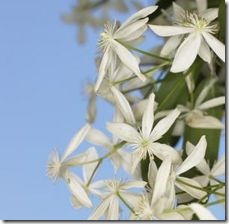Also known as Japanese clematis, sweet autumn clematis (Clematis terniflora) is a flowering member of the buttercup family that offers a robust, sprawling habit and a profusion of late season blooms. Sweet autumn clematis is one of the easiest clematis plants to grow, and does well with little to no care.
Appearance
-
Sweet autumn clematis may grow to be up to 30 feet long, boasting a semiwoody main stem and glossy, deciduous compound leaves. Leaves are accented by fragrant, star-shaped white flowers that are about an inch in diameter. Branching panicles of flowers appear in late summer and continue on until the end of autumn. Seed heads are feathery and silvery gray. Sweet cultivars include Purity, a variety that offers larger flowers.
Location
-
A native of Japan, sweet autumn clematis is a suitable landscape plant for USDA zones 5 to 10. Like other clematis plants, sweet autumn clematis requires a shaded location for its roots and a sunny location for its foliage. Plant in the shade of a rock, tree or structure, and mulch well with an organic medium. The vine will sprawl outwards to find sunlight on its own.
Culture
-
Sweet autumn clematis is easy to grow in an average soil so long as it is well draining. Water regularly to encourage the strongest growth, especially during prolonged summer growth. Sweet autumn clematis has a vigorous, aggressive growth habit and should be pruned hard in the fall, or in the spring after flowering. Without annual pruning, the plant may become invasive in the home garden and crowd out other plants.
Problems
-
Sweet autumn clematis is not susceptible to any major pests or diseases, and is a remarkably healthy plant. The vine is listed as a Category II invasive species in both central and northern Florida by the Florida Exotic Plant Council. Check a local invasive plant species list before growing sweet autumn clematis, as the plant may escape cultivation and threaten local plant communities. Growth should be monitored in any case to keep the vine from growing out of control.


Deprecated: strpos(): Passing null to parameter #1 ($haystack) of type string is deprecated in /home/agriviek8Qv/agriviet.net/public_html/wp-includes/comment-template.php on line 2522